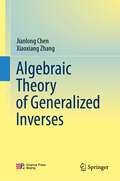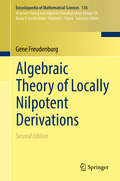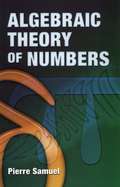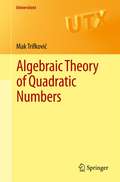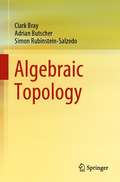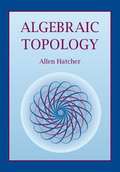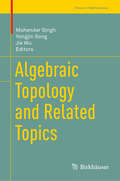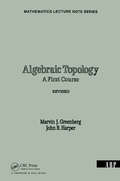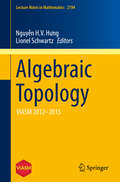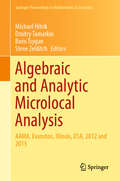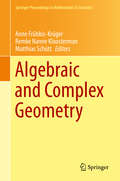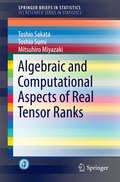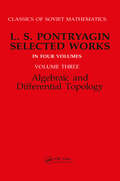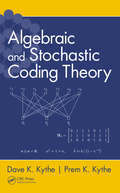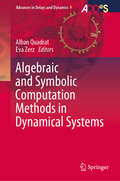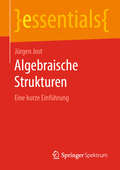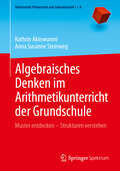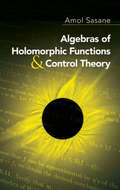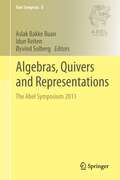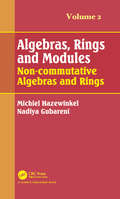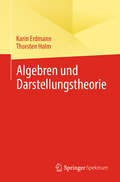- Table View
- List View
Algebraic Theory of Generalized Inverses
by Jianlong Chen Xiaoxiang ZhangMost of the existing monographs on generalized inverses are based on linear algebra tools and geometric methods of Banach (Hilbert) spaces to introduce generalized inverses of complex matrices and operators and their related applications, or focus on generalized inverses of matrices over special rings like division rings and integral domains, and does not include the results in general algebraic structures such as arbitrary rings, semigroups and categories, which are precisely the most general cases.In this book, five important generalized inverses are introduced in these algebraic structures. Moreover, noting that the (pseudo) core inverse was introduced in the last decade and has attracted much attention, this book also covers the very rich research results on it, so as to be a necessary supplement to the existing monographs. This book starts with decompositions of matrices, introduces the basic properties of generalized inverses of matrices, and then discusses generalizedinverses of elements in rings and semigroups, as well as morphisms in categories. The algebraic nature of generalized inverses is presented, and the behavior of generalized inverses are related to the properties of the algebraic system.Scholars and graduate students working on the theory of rings, semigroups and generalized inverses of matrices and operators will find this book helpful.
Algebraic Theory of Locally Nilpotent Derivations (Encyclopaedia of Mathematical Sciences #136.3)
by Gene FreudenburgThis book explores the theory and application of locally nilpotent derivations, a subject motivated by questions in affine algebraic geometry and having fundamental connections to areas such as commutative algebra, representation theory, Lie algebras and differential equations. The author provides a unified treatment of the subject, beginning with 16 First Principles on which the theory is based. These are used to establish classical results, such as Rentschler's Theorem for the plane and the Cancellation Theorem for Curves. More recent results, such as Makar-Limanov's theorem for locally nilpotent derivations of polynomial rings, are also discussed. Topics of special interest include progress in classifying additive actions on three-dimensional affine space, finiteness questions (Hilbert's 14th Problem), algorithms, the Makar-Limanov invariant, and connections to the Cancellation Problem and the Embedding Problem. A lot of new material is included in this expanded second edition, such as canonical factorization of quotient morphisms, and a more extended treatment of linear actions. The reader will also find a wealth of examples and open problems and an updated resource for future investigations.
Algebraic Theory of Numbers
by Pierre Samuel Allan J. SilbergerAlgebraic number theory introduces students not only to new algebraic notions but also to related concepts: groups, rings, fields, ideals, quotient rings and quotient fields, homomorphisms and isomorphisms, modules, and vector spaces. Author Pierre Samuel notes that students benefit from their studies of algebraic number theory by encountering many concepts fundamental to other branches of mathematics — algebraic geometry, in particular.This book assumes a knowledge of basic algebra but supplements its teachings with brief, clear explanations of integrality, algebraic extensions of fields, Galois theory, Noetherian rings and modules, and rings of fractions. It covers the basics, starting with the divisibility theory in principal ideal domains and ending with the unit theorem, finiteness of the class number, and the more elementary theorems of Hilbert ramification theory. Numerous examples, applications, and exercises appear throughout the text.
Algebraic Theory of Quadratic Numbers (Universitext)
by Mak TrifkovićBy focusing on quadratic numbers, this advanced undergraduate or master's level textbook on algebraic number theory is accessible even to students who have yet to learn Galois theory. The techniques of elementary arithmetic, ring theory and linear algebra are shown working together to prove important theorems, such as the unique factorization of ideals and the finiteness of the ideal class group The book concludes with two topics particular to quadratic fields: continued fractions and quadratic forms The treatment of quadratic forms is somewhat more advanced than usual, with an emphasis on their connection with ideal classes and a discussion of Bhargava cubes. The numerous exercises in the text offer the reader hands-on computational experience with elements and ideals in quadratic number fields The reader is also asked to fill in the details of proofs and develop extra topics, like the theory of orders Prerequisites include elementary number theory and a basic familiarity with ring theory.
Algebraic Thinking Foundations (3rd Edition)
by Brian E. Enright Linda L. Mannhardt Leslie G. BakerAlgebraic thinking is much more than a formal course called Algebra and here it refers to mathematics of the type used every day both in the home and the workplace--from rates of auto fuel consumption to planning budgets.
Algebraic Thinking, Part One (3rd Edition)
by Brian E. Enright Linda L. Mannhardt Leslie G. BakerThis mathematics book is aimed at helping students improve and understand algebraic reasoning.
Algebraic Thinking, Part Two (4th Edition)
by Brian E. Enright Linda L. Mannhardt Leslie G. Baker Lisa O. Schueren Colleen E. WeldAlgebraic Thinking Part 2 equips students to find algebraic answers by thinking and using manipulatives.
Algebraic Topology
by Simon Rubinstein-Salzedo Clark Bray Adrian ButscherAlgebraic Topology is an introductory textbook based on a class for advanced high-school students at the Stanford University Mathematics Camp (SUMaC) that the authors have taught for many years. Each chapter, or lecture, corresponds to one day of class at SUMaC. The book begins with the preliminaries needed for the formal definition of a surface. Other topics covered in the book include the classification of surfaces, group theory, the fundamental group, and homology. This book assumes no background in abstract algebra or real analysis, and the material from those subjects is presented as needed in the text. This makes the book readable to undergraduates or high-school students who do not have the background typically assumed in an algebraic topology book or class. The book contains many examples and exercises, allowing it to be used for both self-study and for an introductory undergraduate topology course.
Algebraic Topology
by Allen HatcherIn most major universities one of the three or four basic first-year graduate mathematics courses is algebraic topology. This introductory text is suitable for use in a course on the subject or for self-study, featuring broad coverage and a readable exposition, with many examples and exercises. The four main chapters present the basics: fundamental group and covering spaces, homology and cohomology, higher homotopy groups, and homotopy theory generally. The author emphasizes the geometric aspects of the subject, which helps students gain intuition. A unique feature is the inclusion of many optional topics not usually part of a first course due to time constraints: Bockstein and transfer homomorphisms, direct and inverse limits, H-spaces and Hopf algebras, the Brown representability theorem, the James reduced product, the Dold-Thom theorem, and Steenrod squares and powers.
Algebraic Topology and Related Topics (Trends in Mathematics)
by Jie Wu Mahender Singh Yongjin SongThis book highlights the latest advances in algebraic topology, from homotopy theory, braid groups, configuration spaces and toric topology, to transformation groups and the adjoining area of knot theory. It consists of well-written original research papers and survey articles by subject experts, most of which were presented at the “7th East Asian Conference on Algebraic Topology” held at the Indian Institute of Science Education and Research (IISER), Mohali, Punjab, India, from December 1 to 6, 2017. Algebraic topology is a broad area of mathematics that has seen enormous developments over the past decade, and as such this book is a valuable resource for graduate students and researchers working in the field.
Algebraic Topology: A First Course (Contemporary Mathematics Ser. #Vol. 58)
by Marvin J. GreenbergGreat first book on algebraic topology. Introduces (co)homology through singular theory.
Algebraic Topology: VIASM 2012–2015 (Lecture Notes in Mathematics #2194)
by H. V. Hưng Nguyễn Lionel SchwartzHeld during algebraic topology special sessions at the Vietnam Institute for Advanced Studies in Mathematics (VIASM, Hanoi), this set of notes consists of expanded versions of three courses given by G. Ginot, H. -W. Henn and G. Powell. They are all introductory texts and can be used by PhD students and experts in the field. Among the three contributions, two concern stable homotopy of spheres: Henn focusses on the chromatic point of view, the Morava K(n)-localization and the cohomology of the Morava stabilizer groups. Powell's chapter is concerned with the derived functors of the destabilization and iterated loop functors and provides a small complex to compute them. Indications are given for the odd prime case. Providing an introduction to some aspects of string and brane topology, Ginot's contribution focusses on Hochschild homology and its generalizations. It contains a number of new results and fills a gap in the literature.
Algebraic and Analytic Microlocal Analysis: Aama, Evanston, Illinois, Usa, 2012 And 2013 (Springer Proceedings in Mathematics & Statistics #269)
by Michael Hitrik Dmitry Tamarkin Boris Tsygan Steve ZelditchThis book presents contributions from two workshops in algebraic and analytic microlocal analysis that took place in 2012 and 2013 at Northwestern University. Featured papers expand on mini-courses and talks ranging from foundational material to advanced research-level papers, and new applications in symplectic geometry, mathematical physics, partial differential equations, and complex analysis are discussed in detail. Topics include Procesi bundles and symplectic reflection algebras, microlocal condition for non-displaceability, polarized complex manifolds, nodal sets of Laplace eigenfunctions, geodesics in the space of Kӓhler metrics, and partial Bergman kernels. This volume is a valuable resource for graduate students and researchers in mathematics interested in understanding microlocal analysis and learning about recent research in the area.
Algebraic and Complex Geometry: In Honour of Klaus Hulek's 60th Birthday (Springer Proceedings in Mathematics & Statistics #71)
by Anne Frühbis-Krüger Remke Nanne Kloosterman Matthias SchüttSeveral important aspects of moduli spaces and irreducible holomorphic symplectic manifolds were highlighted at the conference "Algebraic and Complex Geometry" held September 2012 in Hannover, Germany. These two subjects of recent ongoing progress belong to the most spectacular developments in Algebraic and Complex Geometry. Irreducible symplectic manifolds are of interest to algebraic and differential geometers alike, behaving similar to K3 surfaces and abelian varieties in certain ways, but being by far less well-understood. Moduli spaces, on the other hand, have been a rich source of open questions and discoveries for decades and still continue to be a hot topic in itself as well as with its interplay with neighbouring fields such as arithmetic geometry and string theory. Beyond the above focal topics this volume reflects the broad diversity of lectures at the conference and comprises 11 papers on current research from different areas of algebraic and complex geometry sorted in alphabetic order by the first author. It also includes a full list of speakers with all titles and abstracts.
Algebraic and Computational Aspects of Real Tensor Ranks (SpringerBriefs in Statistics)
by Toshio Sakata Toshio Sumi Mitsuhiro MiyazakiThis book provides comprehensive summaries of theoretical (algebraic) and computational aspects of tensor ranks, maximal ranks, and typical ranks, over the real number field. Although tensor ranks have been often argued in the complex number field, it should be emphasized that this book treats real tensor ranks, which have direct applications in statistics. The book provides several interesting ideas, including determinant polynomials, determinantal ideals, absolutely nonsingular tensors, absolutely full column rank tensors, and their connection to bilinear maps and Hurwitz-Radon numbers. In addition to reviews of methods to determine real tensor ranks in details, global theories such as the Jacobian method are also reviewed in details. The book includes as well an accessible and comprehensive introduction of mathematical backgrounds, with basics of positive polynomials and calculations by using the Groebner basis. Furthermore, this book provides insights into numerical methods of finding tensor ranks through simultaneous singular value decompositions.
Algebraic and Differential Topology
by R.V. GamkrelidzeAlgebraic and Differential Topology presents in a clear, concise, and detailed manner the fundamentals of homology theory. It first defines the concept of a complex and its Betti groups, then discusses the topolgoical invariance of a Betti group. The book next presents various applications of homology theory, such as mapping of polyhedrons onto other polyhedrons as well as onto themselves. The third volume in L.S. Pontryagin's Selected Works, this book provides as many insights into algebraic topology for today's mathematician as it did when the author was making his initial endeavors into this field.
Algebraic and Stochastic Coding Theory
by Prem K. Kythe Dave K. KytheUsing a simple yet rigorous approach, Algebraic and Stochastic Coding Theory makes the subject of coding theory easy to understand for readers with a thorough knowledge of digital arithmetic, Boolean and modern algebra, and probability theory. It explains the underlying principles of coding theory and offers a clear, detailed description of each code. More advanced readers will appreciate its coverage of recent developments in coding theory and stochastic processes. After a brief review of coding history and Boolean algebra, the book introduces linear codes, including Hamming and Golay codes. It then examines codes based on the Galois field theory as well as their application in BCH and especially the Reed–Solomon codes that have been used for error correction of data transmissions in space missions. The major outlook in coding theory seems to be geared toward stochastic processes, and this book takes a bold step in this direction. As research focuses on error correction and recovery of erasures, the book discusses belief propagation and distributions. It examines the low-density parity-check and erasure codes that have opened up new approaches to improve wide-area network data transmission. It also describes modern codes, such as the Luby transform and Raptor codes, that are enabling new directions in high-speed transmission of very large data to multiple users. This robust, self-contained text fully explains coding problems, illustrating them with more than 200 examples. Combining theory and computational techniques, it will appeal not only to students but also to industry professionals, researchers, and academics in areas such as coding theory and signal and image processing.
Algebraic and Symbolic Computation Methods in Dynamical Systems (Advances in Delays and Dynamics #9)
by Alban Quadrat Eva ZerzThis book aims at reviewing recent progress in the direction of algebraic and symbolic computation methods for functional systems, e.g. ODE systems, differential time-delay equations, difference equations and integro-differential equations. In the nineties, modern algebraic theories were introduced in mathematical systems theory and in control theory. Combined with real algebraic geometry, which was previously introduced in control theory, the past years have seen a flourishing development of algebraic methods in control theory. One of the strengths of algebraic methods lies in their close connections to computations. The use of the above-mentioned algebraic theories in control theory has been an important source of motivation to develop effective versions of these theories (when possible). With the development of computer algebra and computer algebra systems, symbolic methods for control theory have been developed over the past years. The goal of this book is to propose a partial state of the art in this direction. To make recent results more easily accessible to a large audience, the chapters include materials which survey the main mathematical methods and results and which are illustrated with explicit examples.
Algebraische Strukturen: Eine kurze Einführung (essentials)
by Jürgen JostDie Konzepte in der Algebra wie Gruppen, Ringe, Körper gewinnen ihre mathematische Bedeutung und Kraft aus der Verbindung von abstrakten Strukturen und wichtigen Beispielen. Dieses essential bietet eine kompakte Einführung in diese algebraischen Strukturen und deren Zusammenwirken beispielsweise in der Galoistheorie. Die zentralen Beispiele, also die ganzen, rationalen, reellen und p-adischen Zahlen und die symmetrischen Gruppen, motivieren und veranschaulichen die abstrakten Konzepte. Die Leser*innen gewinnen eine gute Übersicht über die strukturellen Grundlagen der Algebra und bekommen einen Ausblick auf weiterführende Themen.
Algebraisches Denken im Arithmetikunterricht der Grundschule: Muster entdecken – Strukturen verstehen (Mathematik Primarstufe und Sekundarstufe I + II)
by Kathrin Akinwunmi Anna Susanne SteinwegDieses Buch thematisiert algebraisches Denken in der Grundschule als wesentlichen Kern der übergreifenden Leitidee „Muster, Strukturen und funktionaler Zusammenhang“ in den aktuellen KMK-Bildungsstandards.Für algebraische Lehr-Lernprozesse ist eine Unterscheidung zwischen sichtbaren Mustern und allgemeinen Strukturen wesentlich; eine solche wird hier vorgelegt und an vielen Beispielen konkretisiert: Muster machen aufmerksam und lassen neugierig werden. Die Suche nach Begründungen des Musters erwartet, die Tür zu dahinterliegenden Strukturen zu öffnen. Strukturen, d. h. die mathematischen Eigenschaften und Relationen, können so als ursächlich für die Regelmäßigkeit des Musters erkannt werden.Für die unterrichtliche Förderung und gezielte Unterstützung der algebraischen Denkentwicklung werden in diesem Buch einerseits Grundideen algebraischen Denkens für den Arithmetikunterricht ausgearbeitet und andererseits Prinzipien für Unterricht zu algebraischen Grundideen und ihr Zusammenspiel mit prozessbezogenen, allgemeinen Kompetenzen erläutert. Den vier algebraischen Grundideen folgend werden vielfältige, didaktisch aufbereitete Anregungen zur praktischen Umsetzung sowie jeweils entsprechendes Hintergrundwissen angeboten.Das Buch richtet sich an Lehramtsstudierende, an angehende und bereits praktizierende Lehrkräfte sowie an Personen, die in der Lehrerinnen- und Lehrerbildung tätig sind.
Algebras of Holomorphic Functions and Control Theory
by Amol SasaneThis accessible, undergraduate-level text illustrates the role of algebras of holomorphic functions in the solution of an important engineering problem: the stabilization of a linear control system. Its concise and self-contained treatment avoids the use of higher mathematics and forms a bridge to more advanced treatments. The treatment consists of two components: the algebraic framework, which serves as the abstract language for posing and solving the problem of stabilization; and the analysis component, which examines properties of specific rings of holomorphic functions. Elementary, self-contained, and constructive proofs elucidate the explorations of rings of holomorphic functions relevant in control theory. Introductory chapters on control theory and stable transfer functions are followed by surveys of unstable plants and the stabilization problem and its solution. The text concludes with suggestions for further reading and a bibliography.
Algebras, Quivers and Representations: The Abel Symposium 2011 (Abel Symposia #8)
by Idun Reiten Øyvind Solberg Aslak Bakke BuanThis book features survey and research papers from The Abel Symposium 2011: Algebras, quivers and representations, held in Balestrand, Norway 2011. It examines a very active research area that has had a growing influence and profound impact in many other areas of mathematics like, commutative algebra, algebraic geometry, algebraic groups and combinatorics. This volume illustrates and extends such connections with algebraic geometry, cluster algebra theory, commutative algebra, dynamical systems and triangulated categories. In addition, it includes contributions on further developments in representation theory of quivers and algebras. Algebras, Quivers and Representations is targeted at researchers and graduate students in algebra, representation theory and triangulate categories.
Algebras, Rings and Modules, Volume 2: Non-commutative Algebras and Rings
by Michiel Hazewinkel Nadiya M. GubareniThe theory of algebras, rings, and modules is one of the fundamental domains of modern mathematics. General algebra, more specifically non-commutative algebra, is poised for major advances in the twenty-first century (together with and in interaction with combinatorics), just as topology, analysis, and probability experienced in the twentieth century. This is the second volume of Algebras, Rings and Modules: Non-commutative Algebras and Rings by M. Hazewinkel and N. Gubarenis, a continuation stressing the more important recent results on advanced topics of the structural theory of associative algebras, rings and modules.
Algebren und Darstellungstheorie
by Karin Erdmann Thorsten HolmDieses sorgfältig verfasste Lehrbuch bietet eine zugängliche Einführung in die Darstellungstheorie von Algebren, einschließlich Darstellungen von Köchern. Das Buch beginnt mit grundlegenden Themen zu Algebren und Moduln und behandelt fundamentale Ergebnisse wie den Satz von Jordan-Hölder über Kompositionsreihen, den Satz von Artin-Wedderburn über die Struktur halbeinfacher Algebren und den Satz von Krull-Schmidt über unzerlegbare Moduln. Die Autoren behandeln anschließend detailliert Darstellungen von Köchern bis hin zu einem vollständigen Beweis von Gabriels berühmtem Satz, der die Darstellungstypen von Köchern anhand von Dynkin-Diagrammen charakterisiert. Das Lehrbuch benötigt nur Grundkenntnisse über lineare Algebra sowie Gruppen, Ringe und Körper und richtet sich an Studierende ab dem dritten Studienjahr. Mit zahlreichen Beispielen, die abstrakte Konzepte veranschaulichen, und mehr als 200 Übungen (mit Lösungen zu etwa einem Drittel davon), bietet das Buch eine beispielorientierte Einführung, die sich sowohl für das Selbststudium als auch zur Begleitung von Vorlesungen eignet.
Algeria: Statistical Appendix
by International Monetary FundA report from the International Monetary Fund.
